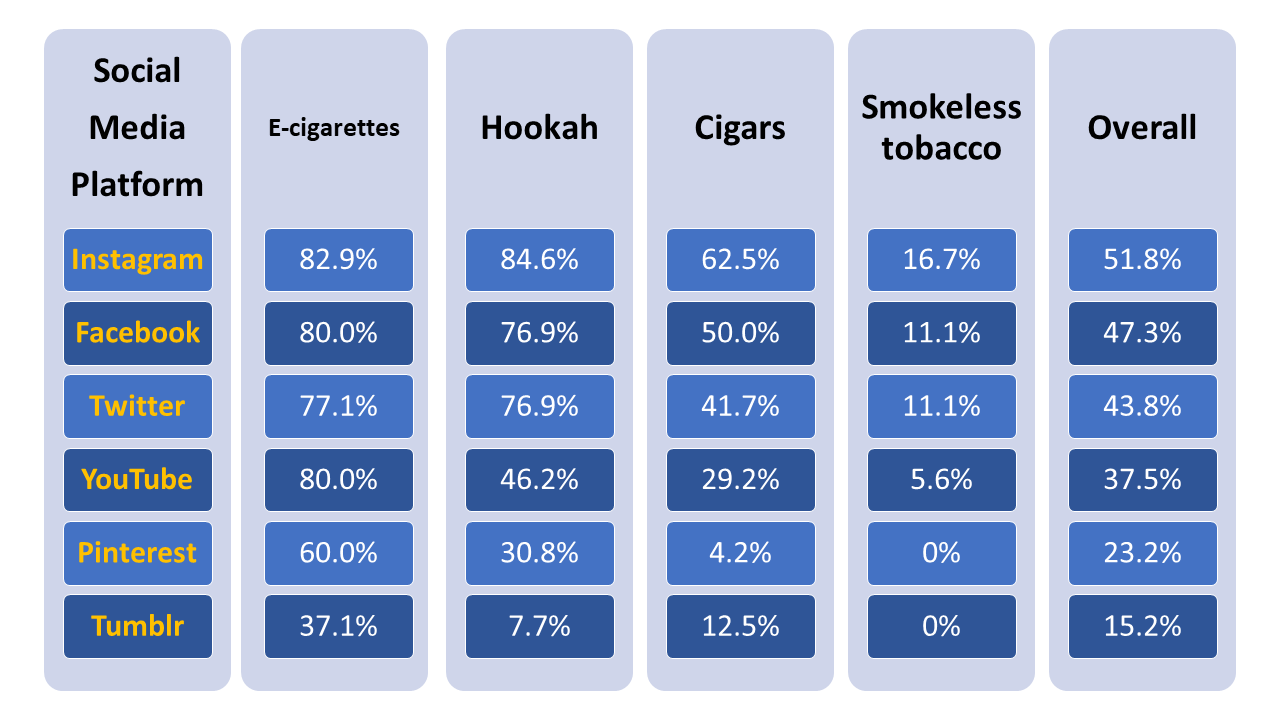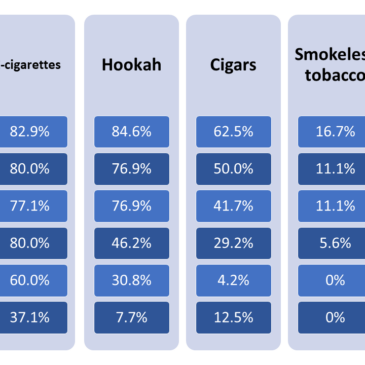Social media began as a way to manage personal social networks. Over time, it has expanded considerably as a platform for business and marketing. At the same time, there has been a growth in use of alternative tobacco products in recent years, such as e-cigarettes, hookah and smokeless tobacco. Despite these parallel trends, few studies have focused on understanding how tobacco companies use social media to reach current and potential customers. In this week’s ASHES, we review a study by Erin O’Brien and colleagues that examined how major tobacco brands in the United States use social media to reach potential users.
What were the research questions?
What social media platforms are used by different types of tobacco brands? How do these brands use social media platforms? What is the reach of each brand in terms of number of social media page followers?
What did the researchers do?
The researchers first analyzed several market research studies of tobacco companies to create a list of the 112 major tobacco brands in the United States during 2017 and 2018. Next, they used these brand names as key terms to search Instagram, Facebook, Twitter, YouTube, Pinterest, and Tumblr for official brand pages, and then collected data on the characteristics of each page. These characteristics included: 1) presence of an age restriction or health warning, 2) page features, including whether the brand used hashtags1, 3) elements of the page’s content (e.g., whether it mentioned flavors), and 4) the number of followers for each page. The researchers used content analysis to summarize what they found.
What did they find?
E-cigarette brands were most likely to have a social media page, followed by hookah and cigar brands. Tobacco companies used Instagram, Facebook2, Twitter, and YouTube the most; Pinterest and Tumblr were less popular (see Figure). For all social media platforms, less than half of tobacco brands included either an age restriction or a health warning, with Facebook having the largest percentage with age restrictions (33% of brands on Facebook) and Instagram having the largest percentage with health warnings (36% of brands on Instagram). Pages on Instagram were most likely to use hashtags, and about one in four brand pages mentioned flavors on each platform. Facebook had the highest median number of brand followers overall, followed by Instagram and Twitter.

Figure. Tobacco brand presence on six social media platforms. Percentages shown are the percentage of company brands for each type of tobacco product that had an official page and at least one post on each social media platform. The total number of brands for each product category were as follows: 35 for e-cigarettes, 13 for hookah, 24 for cigars, and 18 for smokeless tobacco. The final “Overall” column shows the percentage of all brands overall (n = 112; including cigarette brands) that had an official page and at least one post on each social media platform. Click image to enlarge.
Why do these findings matter?
Tobacco companies have a considerable presence on social media platforms and engage in similar marketing approaches to companies in other market sectors. Whereas tobacco advertising has been severely restricted (e.g., in print media) or banned outright (e.g., in transit advertisements) in many countries, social media is mostly unrestricted, making it a potentially popular medium for tobacco advertising with little oversight. This type of advertising is particularly risky among young people, who spend a great deal of time on social media. Importantly, better automated tools such as age-gating (preventing access to pages for underage consumers) and prominent health warnings might serve as effective tools for reducing these risks related to tobacco brand advertising on social media.
Every study has limitations. What are the limitations in this study?
The authors only examined six social media platforms, meaning that some popular social media platforms such as TikTok and Snapchat were excluded. Some research has shown that a portion of social media followers are controlled by “bots” and might not be real people, meaning the analyses of the number of followers might not be fully valid.
For more information:
The National Institutes of Health (NIH) SmokeFree program has tips and resources for people who would like to explore options to help quit smoking. For self-help tools, please visit The BASIS Addiction Resources page.
Health professionals and addiction specialists have been increasingly focused on mental health as it pertains to COVID-19. They have assembled resources specific to COVID-19-related concerns, as well as resources on substance use in general, which can be found on the National Institute on Drug Abuse and Centers for Disease Control and Prevention websites.
— Eric R. Louderback, PhD
What do you think? Please use the comment link below to provide feedback on this article.
________________
[1] Hashtags refer to words or phrases appearing after a “#” symbol (e.g., #socialmedia), and are used to signify that a social media post is about a certain topic or theme. Hashtags are especially popular among young people and often follow pop culture trends, making their use on tobacco brand pages particularly risky for potentially promoting youth tobacco use.
[2] There was only one brand page for conventional cigarettes in the whole study, which was a page for Pall Mall cigarettes on Facebook. It is possible that cigarettes—which have traditionally been viewed as a more harmful tobacco product and have more stringent advertising standards—are restricted to a greater degree by social media companies, explaining the absence of brand pages.




